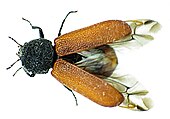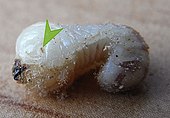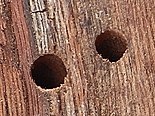Ruby nasturtium beetle
| Ruby nasturtium beetle | ||||||||||||
|---|---|---|---|---|---|---|---|---|---|---|---|---|

Nasturtium beetle ( bostrichus capucinus ) |
||||||||||||
| Systematics | ||||||||||||
|
||||||||||||
| Scientific name | ||||||||||||
| Bostrichus capucinus | ||||||||||||
| ( Linnaeus , 1758) |
The carmine nasturtium ( Bostrichus capucinus , syn .: Bostrychus capucinus ) is also called the red nasturtium or just the nasturtium . It is the most imposing of the fifteen species of the borer beetle family (Bostrichidae), which are also native to Central Europe and are mainly found in the tropics. The strikingly colored beetle prefers warm, dry areas and is not shy.
Comments on names and systematics
The beetle owes its species name "capucinus" ( Latin capucīnus Kapuziner) and the German name Kapuzinerkäfer to the fact that it hides its head under the pronotum as if under a hood. The part of the name "carmine" refers to the color of the beetle's wing covers. The genus name Bóstrychus , from ancient Gr . βόστρυχος bóstrychos, lock of hair; Aristotle's male firefly, goes back to Geoffroy , who classifies the genus between the weevils and the spotted beetles . He says: Nous lui avons donné le nom de bostrichus , à cause de son corcelet qui est velu et chargé de petits poils, qui à la loupe paroissent frisés ( fr . : We gave him / her the name Bostrichus because of his breastplate, the is rough and covered with small hairs, which appear curled under the rag) After other species of the genus have been placed in their own genera, the nasturtium is the only species of the genus. The first description was made by Linnaeus in 1758 in the famous 10th edition of his Systema naturae , whereby the species was still placed in the collective genus Dermestes .
Description of the beetle
The beetle varies considerably in body size, usually between eight and thirteen millimeters long. It shows the elongated cylindrical shape characteristic of the family with the voluminous pronotum under which the small head is hidden.
The mouthparts point downwards. The jaw probes are four-part, the lip probes are three-part. The antennae end in a three-part, loose antenna lobe (clearly visible in Fig. 2 below). They are not angled (kneeled). This distinguishes the borer from the bark beetles , which similarly shaped species occur.
The inflated pronotum has rasp-like teeth on the top, which are particularly prominent at the front. However, the shape of the teeth varies from person to person and wears out with age. The pronotum, breast and first sternite are black.
The elytra are usually orange-red to brick-red, but can also be partially or very rarely completely black ( aberration luctuosus ).
Only 5 abdominal rings ( abdominal sternite ) are visible from below . The first abdominal sternite is about the same length as the second. Its extension converges in a wedge shape to form a lamella between the rear hips. The abdominal sternites are red except for the darkened first one (Fig. 2 above). The posterior hip cavities are unrimmed.
The tarsi are all five-limbed, but the first tarsal is so small that it can be overlooked. The second tarsal segment is very large and larger than the third, this in turn larger than the fourth (best visible in the hind legs in Fig. 1 above). The claw member is strong again. Overall, the tarsi are about as long as the rails.
 
|
  
|
| Fig. 1: Development of the wings | Fig. 2: Different views |

|

|
| Fig. 3: Larva, arrow on stigma | Fig. 4: Loopholes |
Construction of the larva
Like all beetle larvae living in wood, the larva (Fig. 3) is pale and soft-skinned. Only the small round head with the mouthparts is heavily chitinized and dark in color.
The chest section is spherically thickened and shows a large stigma on the side (Fig. 3, green arrowhead). There are three pairs of legs on the chest. The abdomen is curved forward.
In contrast to the similar larvae of the rodent beetle , the larvae of the nasturtium and the other species of the family have forward-pointing four-membered antennae.
biology
The beetle can be found in sparse forests, on vineyards, on wood stores, and also in apartments. It lives mainly at the base of the trunks or on dry roots. It is found on oak , vines and trees belonging to the rose family, more rarely on beech and poplar . The image gnaws at wood.
The beetles can move about in the air (Fig. 1 below). They like to sit motionless on wood lying in the sun or move jerkily around small distances. When alarmed, they quickly run away or fall.
If a male meets a female willing to mate, courtship begins. Otherwise, the female will quickly run away. In courtship, the male touches the female first with the antennae, then with the front legs. Then it stands behind the female and uses the front tarsi to trick the tips of the elytra of the female laterally, while it scans the end of the female's body with lip and jaw probes. If the female remains calm, the male turns 180 ° to mate so that the ends of the abdomen of the male and the female touch. With the abdomen ends of both partners raised at an angle, copulation takes place.
The duration and success of copulation is largely determined by the female. Due to the averted position, for example, in the event of a jerky movement of the female, the male can no longer find the female sexual opening or the female pulls the male after her during copulation until the copulation breaks off. With undisturbed copulation, the male repeatedly lifts his hind tarsi off the ground, rubs them together and hits them against the partner's stomach.
After copulation, the female looks for a suitable place to lay the eggs. She prefers freshly dead wood that has been felled in a healthy state and therefore contains a lot of carbohydrates . Root wood from trees that have been uprooted in storms is also gladly accepted. The wood has to be in a sunny spot, since rot, destroys the substances that can be used by the beetle. Cracks in the wood are checked for their suitability first with the feelers and buttons of the mouthparts, then with the sensory tip of the laying tube. Once a suitable spot has been found, three to four eggs are laid with the long laying tube at intervals of half a minute. After a break, some eggs can be laid again in the same place after the re-examination, or another place is sought. The eggs are only placed a little below the surface of the wood, between 50 and 500 eggs in total.
The larvae develop in hard dead wood. There they drill large-volume passages that cross at will. The drill holes are tightly filled with the very fine drilling dust. The development can take several years depending on the supply of nutrients, but as a rule the development of the larva takes 11 months. Since several generations in a row can inhabit the same piece of wood, it can be completely gnawed into drilling dust inside. The exit holes are circular (Fig. 4).
The adult animals can also drill in the wood. The carbohydrates ingested are broken down by symbiotic microorganisms for digestion . These migrate into the egg cells in the maternal genital tract and are thus transmitted to the offspring.
Occurrence and distribution
The species is not common or rare in Central Europe. In the red lists it is usually listed under Category 3 (endangered). It prefers oak sapwood and types of fruit, and it is also often found on dry roots or vines in warm areas. Due to the processing of infected wood, they can also occur in wood and furniture stores.
In Europe the beetle is absent in some areas and becomes increasingly rare towards the north. However, the species is distributed in the Palearctic from North Africa across Europe to Asia.
supporting documents
Individual evidence
- ↑ a b Bostrichus capucinus in Fauna Europaea (synonyms and distribution)
- ↑ Sigmund Schenkling: Explanation of the scientific beetle names (species)
- ↑ Sigmund Schenkling: Explanation of the scientific beetle names (genus)
- ↑ ELGeoffroy: Histoire des insectes abrégée qui se trouvent aux environs de Paris; First description of the genus in GDZ p.301
- ↑ Bostrichus at BioLib
- ↑ Bostrichus at Fauna Europaea. Retrieved February 14, 2013
- ↑ C.Linnaeus: Systema Naturae per Regna tria naturae, secundum classes, ordines, genera, species, cum characteribus, differentiis, synonymis, locis. Tomus I. Editio decima, reformata first description by GDZ
- ↑ Svatopluk Bílý: Coléoptères, adaptation française Verlag Gründ 1990; ISBN 2-7000-1824-9
- ↑ LODOS, N: A new important pest of furniture in Turkey: Bostrychus capucinus CAB ABSTRACTS Damage to furniture in Turkey ( page no longer available , search in web archives ) Info: The link was automatically marked as defective. Please check the link according to the instructions and then remove this notice.
literature
- Heinz joy , Karl Wilhelm Harde , Gustav Adolf Lohse (ed.): The beetles of Central Europe . tape 8 . Teredilia Heteromera Lamellicornia . Elsevier, Spektrum, Akademischer Verlag, Munich 1969, ISBN 3-8274-0682-X .
- GUNTRAM LOTZ (1979) Bostrychus capucinus (Bostrychidae) -mating behavior and oviposition ENCYCLOPAEDIA CINEMATOGRAPHICA Biol.12 / 17-E 1406, publications on scientific films ISSN 0073-8417 Accompanying publication to the film as PDF
- Edm.Reitter: Fauna Germanica, the beetles of the German Empire III. Volume, KGLutz 'publishing house, Stuttgart 1911
- Klaus Koch : The Beetles of Central Europe Ecology . 1st edition. tape 2 . Goecke & Evers, Krefeld 1989, ISBN 3-87263-040-7 .
Web links
Bostrichus capucinus at Fauna Europaea